DUAL AND SERIES CONNECTIONS/PUMPING
Hooking Up Two Engines At A Fire
Two methods for hooking up two engines at a fire are Dual/Parallel and Series/Relay. Before we get into this... remind yourself of our earlier lessons on Pumping in Parallel and Pumping in Series because that is the foundation for what we are about to learn.
Dual / PARALLEL
For years this was my preferred... heck, even gospel truth, the only way to pump at a fire. I have since learned that both methods have their PROS/CONS, and it's up to you to work with the other apparatus in your district and BC to determine what works best for you.
The fundamentals of Dual or Parallel pumping are:
The Attack Engine makes the fire.
The Second Due (Back-Up Engine) catches the hydrant and forward lays the supply line to the Attack Engine.
Once the Attack Engine has its permanent supply, the two Drivers work together to lay a 3" supply line INTAKE to INTAKE to create a redundant water supply. This allows the Second Due Engine to become a backup in the event of a catastrophic failure with the Attack Engine's pump.
Note: Your Backup line should then come off the Second Engine.
2) Series / Relay
This has become my preferred setup on the fire ground... primarily for two reasons:
Speed - It's simply faster to connect this way at a fire. In our tests, it's by nearly a full minute.
Catastrophic failure doesn't happen that often. The con to Series Pumping that people like to reference is this "catastrophic failure" in which the Supply Engine's pump fails to the point that water will not flow through the discharge side of the pump. If this were to happen, your Attack Engine would be left to only its 500-gallon tank and scrambling for water. But again... this is extremely rare... in fact, in Rick's 38 1/2 year career, this only has occurred once.
The fundamentals of Series/Relay pumping are:
The Attack Engine makes the fire.
The Second Due (Supply Engine) catches the hydrant and forward lays the supply line to itself. Before connecting the Supply line from the hydrant, they work with the Attack Engine to secure a 3" supply line DISCHARGE to INTAKE, providing the Attack Engine with another 500 gallons of water (at idle).
Once the Attack Engine has received the 3" to its intake and now has the Supply Engines 500 gallons as well, the two Drivers work together to lay a secondary 3" supply line DISCHARGE to INTAKE if necessary.
🚨 DISCLAIMER: Dallas Fire-Rescue does not endorse or promote these videos. The information herein is my best understanding of the material covered and the subsequent views expressed are my own and not necessarily those DFR. These videos are strictly for educational purposes only. It is critical that you follow your department's MOP/SOP, and talk with your Station Officer (and crew) before implementing anything you see here on The Roll Steady.
© 2022 THE ROLL STEADY LLC. ALL RIGHTS RESERVED
PUMP SCHOOL W/ RICK BREWER
TABLE OF CONTENTS



